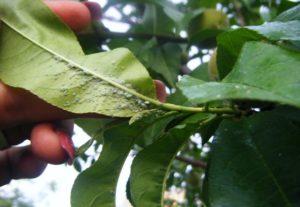Peach aphid is a voracious pest: how to deal with it
Aphids are classified as dangerous pests. There are a huge number of varieties of insects. It is worth paying special attention to the peach look. Parasites can damage not only peach, but also many other crops. Invasion of peach aphids is a big threat to the crop.
Content
What does peach aphid look like
Description of aphids on peach
Name: Green peach aphid, greenhouse
Latin:Myzus persicae subsp. persicaeClass: Insects - Insecta
Squad: Homoptera - Homoptera
family: Real aphids - Aphididae
 | Habitats: | everywhere |
 | Features: | loves parsley, dill, tomatoes, potatoes. |
 | Harm: | carries more than 100 types of viruses |
Female peach aphids come with and without wings. The wingless female is egg-shaped. The size varies from 2 to 2,5 mm. The color is influenced by the culture on which the insect is formed. Coloring can be:
- yellow-green;
- light green;
- pinkish.
The eyes are brown-red. Juice tubules have a cylindrical shape, expanded towards the base. Their length is ¼ of the entire body. The tail is finger-shaped yellow.
The winged female reaches a length of 2 mm. She has a black head and a yellow-green belly. The dorsal side of the abdomen is characterized by a central black spot. Eggs are black shiny. They are oval in shape.
Another variety is the large peach aphid. She looks a little different. Coloration gray-brown. There are black bumps on the back.
Life cycle
In the soil, the development of a non-full-cyclic form of the insect occurs. The colony contains exclusively parthenogenetic ovoviviparous individuals. This is due to the fact that a second host plant is needed for full-cycle development. This plant is the peach.
The larvae of the founders in the Crimea are able to hatch in February-March, in a colder climate - later, by April. This is affected by the air temperature. The kidneys are the first place of food intake. Later, the larvae feed on leaves and flowers.
A female without wings produces 20 to 60 individuals. Rapid development occurs at 25 degrees Celsius. Although the insect calmly tolerates low temperatures. The wingless virgin appears on the peach in April.
The appearance of winged stripes falls at the end of September. After 15 days, amphinogonal female larvae hatch. Usually the quantity reaches 25 pieces. An amphinogonal individual becomes sexually mature after 13-17 days. Stripes appear simultaneously with males and are placed on the peach.
Reproduction begins at 5 degrees Celsius. Larvae develop from 20 to 30 days. The temperature regime should be from 5 to 10 degrees Celsius. The shortening of daylight hours suggests the appearance of winged females.
Habitat
The green peach aphid lives in Eastern and Western Europe, the Southern Urals, China, Japan, India, and North America. Crimea and steppes are the habitat of the large peach aphid.
External signs of damage
Signs of a peach parasite infestation include:
- accumulation of parasites on the inside of the sheets;
- mucus coating of buds, leaves, flowers;
- death of shoot tips;
- curling and drying;
- stop growth and development;
- reduction in fruiting or its absence.
Harm from peach aphids
The pest feeds on peach, tomato, potato, pepper, parsley, lettuce, dill, gerbera, freesia, tulip, chrysanthemum, lemon.
The diet of a large peach aphid consists of peach, plum, cherry plum, almond, cherry, apple tree, apricot.
Methods of control and prevention
To prevent the appearance of peach aphids:
- remove weeds, dry and damaged shoots;
- be sure to burn fallen leaves;
- wash off insects with water;
- carefully dig the soil;
- Bordeaux liquid is applied before sap flow;
- produce sanitary pruning;
- stems whiten.
Among 26 aphid control measures there will definitely be one that will help protect the site.
Conclusion
The appearance of peach aphids is fraught with a significant reduction in yield. It is imperative to carry out annual preventive measures. However, when pests appear, you need to get rid of them. You can use different methods at the same time.

